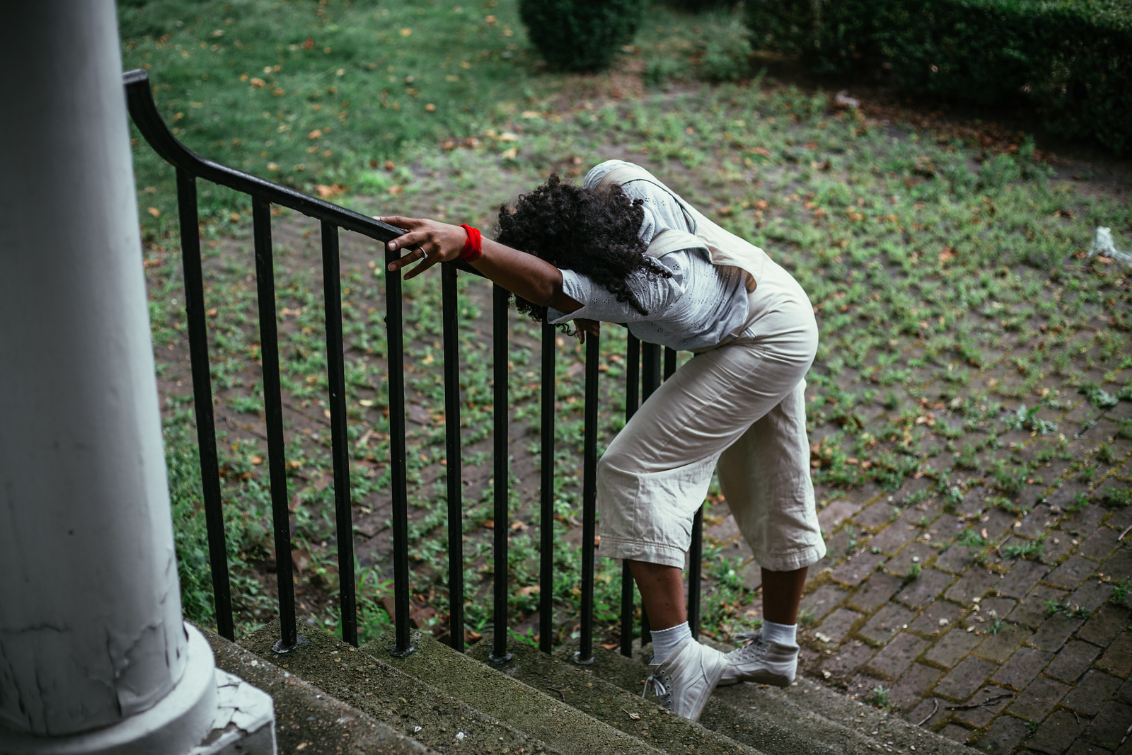Those Before Us
By Rebis; Directed by Jesse Carrey
Produced by Rebis
Off Off Broadway, Site-specific Theatre
Ran through 8.11.19
Nolan Park, Governors Island
by Asya Gorovits on 8.7.19
 Kerime Konur in Those Before Us. Photo by Mike Esperanze.
Kerime Konur in Those Before Us. Photo by Mike Esperanze.
BOTTOM LINE: A site-specific dance and audio piece by Rebis reclaims the history of Governors Island for its marginalized inhabitants.
It's a short ferry ride from Manhattan to Governors Island, but it feels like you are in a parallel universe once you get there. By the time you reach Nolan Park, the location of Those Before Us, the city becomes a distant mirage. Time stops, trapped in shabby red-brick buildings drowning in the sea of greenery. Rebis, a collective of immersive experiences creators led by Katya Stepanov and Jesse Carrey, were able to harvest the sleepy, suspended energy of the island along with its history and pour it into Those Before Us. This meditative multimedia experience combines live dance with pre-recorded audio, delivered through Bose glasses, to expose the flaws of the past and set an intention for a better future.
Besides smart glasses, audience members are supplied with a marked paper map of Nolan Park with specific locations for the experience. The hi- and low-tech combo is representative of the experience itself. Although it is about the past, it is set in the fictional "Terrarium," a place where nothing is real and memories roam around like ghosts. A male voice introduces the rules of engagement as we start, and pops up at the beginning and at the end of each audio track. This broader narrative frame smartly claims the public park as the space of the show. The quick intros and outros of the (several-minutes long) fragments help to navigate the experience (but can also take you out of the story in a way).
Audience members can follow one of the “memories” (one of the four dancers) from one location to the next to hear their story unfold sequentially. Or they can choose to stay in one location and listen to the fragments of the other three narratives. The dancers wear ribbons around their wrists, indicating the colors assigned to each story. The signs on the map and ribbons around the trees marking the locations have corresponding colors, so it’s easy to follow. The two-hour running time of the experience is enough to listen to every single track. I tried both modes, following two of the stories as they were danced out in front of me, and listening to the other two in random order. There is no right way to do it.
The beauty of Those Before Us is its flexibility. Those who reserved Bose glasses don’t even need to scan the codes, as the device reads geo-location and starts the appropriate track. However, if the technology fails or if there are not enough smart glasses, you can scan the QR code with your phone and use your headphones to get the same experience. (I can picture a version of the show without dancers, reduced to just the QR codes on the trees, which anybody can explore.)
Among the performers, Daan Bootsma is particularly expressive; he plays Marcus, the nephew of the West India Company owner who is sent to Governors Island (Noten Eylandt back in 1637) to oversee the construction and operation of a sawmill. From this character, we learn about the terrible treatment of the indigenous people by the corrupt local government, and I could see the confusion and pain coming from the powerlessness of this character. Another character from the island's past is Laura, whom we meet on the morning of her wedding day in 1878; as if listening to her thoughts or reading her diary, we learn about her many concerns regarding this marriage-for-status to a person she doesn’t love. The third voice is of a black soldier from 1917, who is stationed on the island but is bound to dirty service work and bad living conditions because of segregation. The final story is of a gay man in 1964, coming to terms with his sexuality and struggling to remain closeted.
Spanning the course of one day or several years, each personal story is representative of the oppression of colonization, patriarchy, racism, or homophobia. It is painful and bitter to listen to these stories, yet it is empowering to hear history told by those who were once on its periphery. The only thing that didn’t sit right with me is the fact that a white ally was the voice for the struggle of indigenous people, especially compared to the three other marginalized characters, who spoke for themselves. This discrepancy is even stranger considering the emphasis that the production puts on restoring justice for Native Americans (it ends in the American Indian Community House and lists the organization as an advisor).
Those Before Us reminded me that theatre is most powerful when it gives a voice to those who didn’t or don’t have it in their everyday lives. The voices of those before us are the roots of this experience. Site-responsive choreography creates a strong, magnificent trunk, and the technology supplying it is a lush canopy of leaves. Even if it changes, the remaining tree won’t lose the grace of its shape.
(Those Before Us played in Nolan Park on Governors Island through August 11, 2019. The running time was 2 hours with no intermission. For more information visit experiencerebis.com.)
Those Before Us is by Rebis: Stephen Carrey-Chan, Jesse Carrey, Kimberly Dodson, Alex Spieth, and Katya Stepanov. Directed by Jesse Carrey. Produced by Jesse Carrey, Becca Barrett, and Rebis. Lead Experience Designer is Katya Stepanov. Costume Design by Olivia Hearn. Sound Design by Alex Ryaboy. Marketing Directors are Michaela Holland and Karena Phan. PR Director is Toro Adeyemi.
The cast is Daan Bootsma, Mallory Galarza, Kerime Konur, and Ashton Muniz. Voice actors are Jesse Carrey, Ashton Muniz, Grace Rao, Vincent Lidie, and Zach Fifer.

